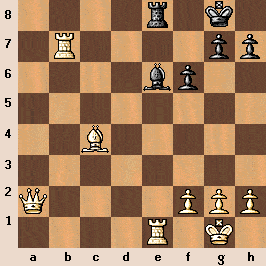Look at the chessboard below. White has a Queen-Bishop Battery (the Queen at a2 and White (King) Bishop at c4). What principles of moving pieces and advancing pawns, and evaluating a game, can you identify from this board position?
 |
White’s Queen-Bishop Battery has Black’s Queen Bishop at e6 pinned to Black’s King at g8. White’s Rook at e1 also has the Bishop pinned to Black’s Rook at e8. There is no way to tell whether the Rooks at e1 and e8 are King Rooks or Queen Rooks or one a King Rook and one a Queen Rook. Most likely, they are King Rooks and got to their squares after moving following a Kingside castle (0-0) by each player. This conclusion is strenghened for White’s Rook because White has another Rook on the board at a7 which is most likely the Queen Rook, although it is possible that White lost a Rook and later effectuated a pawn promotion chosing to promote to a Rook. This seems unlikely from the board position with Black having a Rook at e1 as a defender and protector against a pawn promotion. Black’s King is well-guarded, while Black’s King is not. White clearly has the initiative, and overwhelming material advantage, positional superiority, and better pawn structure (three pawns lined up in front of their King…King Safety).
If Black were to move the Bishop at e6 to any available square in the diagonal except f7, White would have an immediate checkmate on the next move by capturing Black’s Rook at e8 with White’s Rook at e1 (Rxe1#). Black’s pawn advance to f6, opening the white diagonal from a7 to g8 was would be most likely called a bad move (f6?), as this opened Black’s Kingside, giving White an avenue to attack Black’s King and took away the effectiveness of Black’s likely castle. However, it is possible the move was a good move at the time Black made it if Black had compensention at that point. It is also possible that White forced the pawn advance to f6 in some manner earlier in the game. We do not whether either of these are true. Black has as a pawn chain of f6 and g8, but it is ineffectual. There are five open files (a hrough e). White and Black positioned Rooks in the open e file, consistent with attempting to seize control of that file. However, White has won that battle.
Black has inadequate protection for the Bishop, which is protected only by Black’s Rook at e8. White has three pieces attacking the Bishop at e6 – two major pieces (Rook at e1 and Queen at a7 via the battery) and one minor piece (White’s Queen Bishop at c4). The two Bishops are in a Bishop face-off. White also has developed a Rook to Black’s seventh rank and seized control of it. Black should have resigned long ago, but some players especially beginners try to fight to the bitter end. White has an unstoppable mating net in progress, although Black could delay it slightly by advancing his or her h7 pawn (called “luft”) to give the King an out from a back rank checkmate. Regardless, Black has lost the game with checkmate to follow in short order no matter what Black does.
